Expert Guide to Wakeboard Binding Sizing

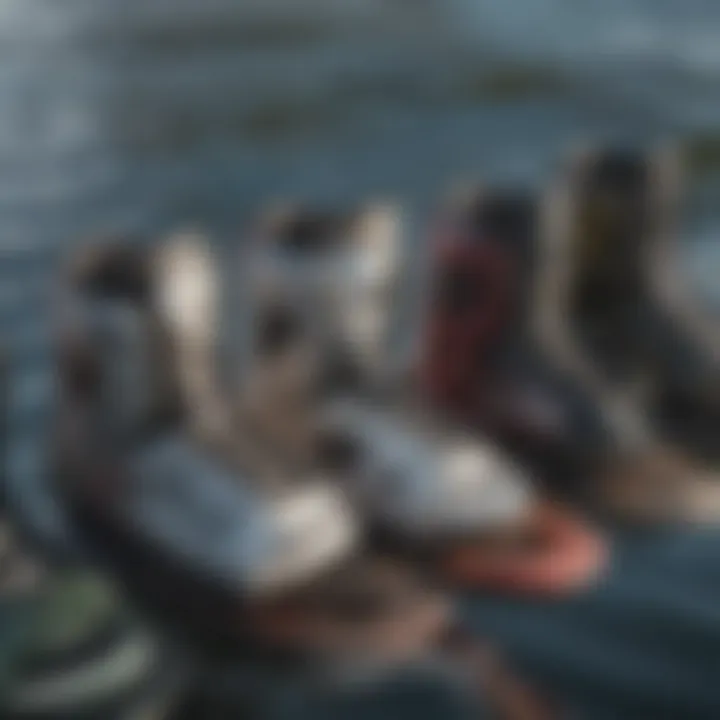
Intro
When it comes to wakeboarding, the right gear can make or break your experience on the water. Among the many elements that contribute to a smooth ride, one that often gets overshadowed is the significance of binding sizing. Just like a pair of well-fitted shoes can boost your comfort and performance in any sport, the appropriate wakeboard bindings ensure optimum fit and safety while you carve through the waves.
This article sets out to dissect the various components of wakeboard binding sizing, shedding light on factors that influence your choice. It’s not just about strapping yourself to a board; it's about having the right connection that empowers you to enjoy your time on the water. Whether you are a seasoned pro or a newcomer eager to catch your first wave, understanding the intricacies of binding sizing is crucial for your performance and overall safety.
So, let’s dive deep into this vital subject of wakeboard binding sizing, exploring the key concepts that every wakeboarder should grasp.
Preamble to Wakeboard Binding Sizing
In the realm of wakeboarding, the significance of binding sizing cannot be overstated. Whether gliding across the water with the wind in your hair or performing the latest trick, having the right bindings can make all the difference. This article explores the essentials of wakeboard binding sizing, ensuring that novices and experienced riders alike understand how to maximize their performance and safety.
Proper binding sizing is not solely about comfort; it plays a critical role in how well a rider connects with their board. Tight or loose bindings can hinder control, making it difficult to execute maneuvers accurately. Therefore, understanding the various aspects of binding sizing, including measurement, fit, and the types of bindings available, becomes crucial. It’s akin to wearing a tailored suit; if it fits poorly, it doesn’t matter how expensive or stylish it is.
Defining Wakeboard Bindings
Wakeboard bindings are essentially the link between the rider and the board. These specialized attachments hold your feet securely as you navigate the waves. Bindings come in various styles, and each is designed for specific riding styles and preferences.
When talking about wakeboard bindings, it’s helpful to categorize them primarily into two types: open-toe and closed-toe bindings. Open-toe bindings offer a bit of flexibility in sizing, accommodating various foot sizes within a certain range. On the other hand, closed-toe bindings are often more performance-oriented. They provide a snugger fit, eliminating any nuisance from movement - ideal for those who prioritize precision in their tricks.
Getting to grips with the function of wakeboard bindings sets the foundation for understanding how sizing impacts experience. A well-chosen binding enhances control and agility, transforming the ride into an exhilarating experience. Conversely, mismatched bindings can rob you of the thrill and leave you feeling frustrated.
Importance of Proper Fit
Proper fit in wakeboard bindings isn’t simply a matter of preference; it's a matter of safety and performance. A binding that doesn't offer the right fit can lead to issues ranging from discomfort to serious injury.
Imagine standing on your wakeboard, feeling your feet slide around in your bindings as you attempt to catch a wave — it's a recipe for disaster. Tight bindings might put undue pressure on certain foot areas, leading to cramps or even numbness. Conversely, loose bindings can lead to your foot being ejected from the board at the worst possible moment, which is both dangerous and damaging to your concentration.
"The right fit provides the confidence to perform at your best while ensuring your safety on the water."
Additionally, when you have a proper fit, you can execute tricks with more accuracy and perform better overall. It’s about creating a harmony between rider and board, ensuring that every twist and turn feels intuitive, not forced. Different riding styles present unique demands, meaning that the emphasis on proper fit can vary, but the underlying principle remains the same: a snug, comfortable fit leads to enhanced performance.
Understanding how to determine the right binding size and fit sets the stage for becoming a better wakeboarder. As we delve deeper into the various factors influencing binding sizing, the importance of this initial understanding cannot be ignored.
Understanding Foot Sizes
Understanding foot sizes is essential for wakeboard binding sizing. It plays a pivotal role in how well a rider can perform on the water. The right size can either enhance or hinder one's experience. So let's dive deep into this topic, starting from the beginning: how to measure foot dimensions accurately and what different sizing systems there are out there.
Measuring Foot Dimensions
To find the right binding size, one must first measure foot dimensions carefully. It’s not just about knowing your shoe size; accurate measurement of both the length and width of the foot is crucial. Here’s a simple method to get it right:
- Find a flat surface and sit down. Make sure your foot can rest comfortably.
- Use a ruler or measuring tape. Place one end at the heel and stretch it towards the longest toe.
- Take note of the length in centimeters or inches. This will give you the basic length size.
- For width, measure around the widest part of the foot. Doing this helps obtain the overall shape of your foot.
These measurements serve as a foundation for understanding personalized fit in wakeboard bindings. Also, measuring both feet is wise, as one foot may be larger than the other, and it’s common!
Different Sizing Systems
With your foot sizes in hand, it’s time to unravel the various sizing systems used globally. Each system has its unique traits, and knowing them can guide you to a proper fit.
US Sizing
When it comes to US sizing, it’s often viewed as a go-to standard for many sports shoes, including wakeboard bindings. The key characteristic here is its straightforwardness. US sizes usually range from 5 to 14 for men and women, but brands can differ a smidge.
A particular feature that makes US sizing favorable is its half sizes. This trait allows riders who have slightly larger or smaller feet than whole numbers to find that perfect balance. However, it does come with its downsides. Because there is no universal standard across all brands, sizing can sometimes vary. Riders may find that a size 10 in one brand feels different than a size 10 in another.
EU Sizing
Moving over to the European sizing system, it follows a metric system, which means that the measurements translate directly to centimeters. The EU sizes are typically numbered from around 35 upwards, making it quite comprehensive. Its relevance in wakeboarding lies in being more consistent across the board as many manufacturers base their sizes on this scale.
The unique aspect of EU sizing is that it eliminates many discrepancies found in other systems. For instance, someone who wears a size 42 will often find that size in various brands fits similarly. This aspect is beneficial for folks looking to make consistent choices when purchasing.
However, this system may confuse those only familiar with US sizes, requiring some extra conversion effort for accurate fitting.
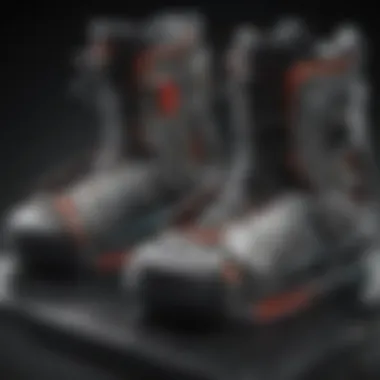
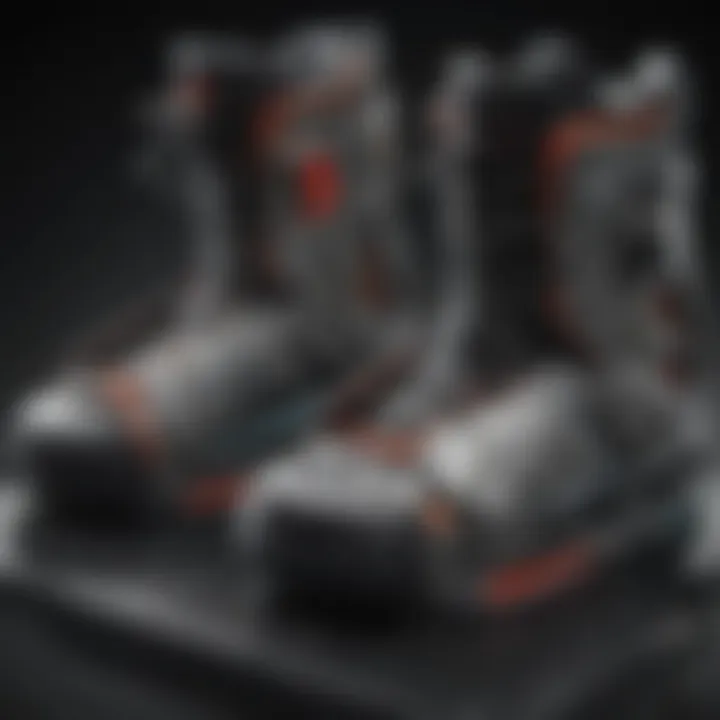
UK Sizing
Finally, let’s not forget about the UK sizing system, which is slightly quirky. UK sizes are typically a half size smaller than US sizes. For example, a US size 10 is usually a UK size 9. The core feature here is its straightforwardness, and it may seem more intuitive for folks already accustomed to this system.
What makes UK sizing noteworthy is how it influences the market. As it’s commonly used in the British context, buyers can easily find bindings that fit well right out of the box. On the flip side, converting from this system to US or EU can be tricky for newcomers, which adds a layer of complexity to the purchasing process.
Understanding these sizing systems is crucial for achieving an ideal fit, ultimately leading to better performance on the water. One swap here could spell the difference between a thrilling ride and a frustrating time!
Types of Wakeboard Bindings
Understanding the types of wakeboard bindings is fundamental to ensuring that your experience on the water is enjoyable and effective. The right bindings not only contribute to your comfort and security but also impact your overall performance and control. Different styles accommodate various riding techniques and preferences, making it essential to grasp the distinctions between them. Let’s delve into two primary categories: open-toe bindings and closed-toe bindings.
Open-Toe Bindings
Open-toe bindings are designed with a more relaxed structure that allows for the tips of the toes to protrude slightly past the end of the binding. This design has its own set of advantages:
- Versatility in Fit: Open-toe bindings can fit a wider range of foot sizes because of their flexible structure. This means if your foot is slightly larger than average, you’re less likely to be squeezed into a tight fit, which can be quite uncomfortable.
- Ideal for Sharing: For those who plan to share equipment or ride in groups with varying foot sizes, these bindings can be a good compromise. Sharing equipment becomes smoother without the fuss of switching bindings.
- Better Ventilation: Since the full foot is not enclosed, these bindings often provide better airflow, reducing the chance of sweaty feet during long sessions.
However, it’s important to note that the trade-off may include less support compared to closed-toe options, particularly during aggressive maneuvers or jumps.
Closed-Toe Bindings
On the flip side, closed-toe bindings offer a snug fit that completely encompasses the foot. This can be a game changer for riders seeking enhanced control and responsiveness. Here’s what you ought to consider:
- Enhanced Support: By wrapping around the foot more securely, closed-toe bindings provide better ankle and heel support. This can be crucial for maintaining stability during high-intensity maneuvers or when you’re pushing the limits of your skills.
- Precision in Control: The tighter fit typically allows for more sensitive control over the board. This kind of binding can enhance a rider’s ability to feel the board underfoot, resulting in more effective transitions and tricks.
- Reduced Chance of Injury: Closed bindings can also help keep your feet in place during sudden movements, reducing the risk of injury that sometimes arises from slippage.
Nevertheless, the snugness can be a double-edged sword. If the fit isn't just right, it might lead to discomfort, especially during longer rides.
Takeaway: The choice between open-toe and closed-toe bindings ultimately comes down to personal preference. Assess your riding style, comfort needs, and how you plan to use your gear.
Understand that investing time in choosing the right bindings correlates directly to the quality of your experience on the water. Finding that perfect balance could be what takes your wakeboarding from average to extraordinary.
Factors Affecting Binding Sizing
When it comes to selecting the right wakeboard bindings, understanding the factors that affect binding sizing is crucial. An ill-fitting binding not only hampers performance but also raises safety concerns. The proper fit can influence control, comfort, and ultimately enhance your overall experience on the water. Here, we explore the various elements that play a vital role in binding sizing, including riding style, skill level, and foot characteristics.
Riding Style
Freestyle
Freestyle riding is all about creativity and expression on the water. If you've ever seen riders flipping and spinning effortlessly, you know that this style requires bindings that allow for maximum flexibility. One of the key characteristics of freestyle riding is the need for bindings that support a wide range of movement. The uniqueness of freestyle lies in the tricks performed; these often demand quick adjustments and the ability to land jumps with precision.
Binders that are slightly looser can be beneficial here. However, having too much room can jeopardize stability. Thus, riders should seek a balance that promotes both mobility and security. An added advantage of using the right freestyle-oriented bindings is the way they facilitate shock absorption, which is essential when landing high-impact tricks.
Slalom
Slalom riding tends to emphasize speed and precision as riders cut back and forth across the wake. The unique challenge here requires bindings that offer firm support, as maintaining control at high speeds is critical. With slalom, greater rigidity in the bindings helps in transferring energy effectively through the board. This characteristic teaches the rider to initiate and complete turns confidently. High-performance slalom bindings can provide a snug fit, ensuring your foot is locked in place to maximize power transfer on each turn. Nevertheless, the downside is the potential for lack of comfort during prolonged sessions if the fit is overly tight.
Skill Level
Rider skill level plays a major role in selecting the right binding size. Beginners might want bindings that offer a bit more room for error, as these can provide a forgiveness that can aid in learning. A snug bind my feel intimidating for those still getting to grips with their balance. On the contrary, advanced riders often seek tighter, more responsive bindings that match their high level of skill and confidence. This way, they can make precise movements with accuracy and speed. It’s essential to take into account that skill growth over time may necessitate re-evaluating binding size and fit. Regardless of skill level, trial and adjustment should be a constant practice.
Foot Width and Shape
Not all feet are created equal, and foot width and shape can significantly influence the choice of bindings. A wide foot might feel cramped in standard bindings, leading to discomfort and an inability to control the board properly. Conversely, if the bindings are too wide, a narrow foot may shift around excessively, making it challenging to perform tricks or maintain balance. Looking for models that offer different width options or customizable fit can be a game changer.
Additionally, foot shape can influence where pressure points may occur. Bindings such as those from Liquid Force and Hyperlite often have design variations to cater to different foot shapes, ensuring a more personalized fit.
A well-fitted binding is akin to putting on a glove; it's got to be snug yet comfortable enough to allow freedom of movement!
In sum, understanding these factors can significantly impact your wakeboarding experience. Whether you're just starting or are a seasoned pro, knowing how riding style, skill level, and foot characteristics can interact with binding sizing is invaluable for enhancing performance and enjoyment on the water.
Selecting the Right Size
Choosing the correct size for wakeboard bindings can make all the difference in the world when it comes to performance on the water. A proper fit enhances not only comfort but also the safety and effectiveness of your riding experience. Getting this aspect right should be one of your top priorities, especially when you're gearing up for that next session. Let's break down why selecting the right size matters and how you can ensure that your bindings fit like a glove.


Trying Bindings On
Before making any purchase, it's always a smart move to actually try the bindings on. Picture this: you’ve got your eye on an eye-catching set at your local shop. But hold your horses! You need to slip your feet into those bindings first. Make sure that your foot fits snugly without being cramped. A good test is to walk around a bit. If you feel any discomfort or tight spots right there in the store, it’s a red flag.
When you try them on, pay attention to a few essential aspects:
- Heel Lock: Your heel should feel secure, with no slipping when you pull your foot back.
- Toes Free: Check that your toes do not hang over the front. They should be comfortably tucked without feeling like they’re getting pinched.
- Overall Flexibility: Bend your knees slightly and see if you can feel the responsiveness of the binding. If your foot feels too restricted, try a different size.
Importantly, look out for specific features like the top strap and how it holds your foot in place. A binding that allows for this sort of adjustment can make a world of difference. If you have any doubts, asking for the advice of seasoned staff in the shop can help steer you in the right direction!
Allowing for Adjustment
Once you're satisfied with the fit during your trial, the next step is to consider the room for adjustment. Good bindings usually come with a bit of leeway, allowing you to tweak the fit as needed. Different riding conditions or styles might call for slight modifications. Here’s why allowing for adjustment is crucial:
- Riding Style: Whether you’re hitting the waves for freestyle or cruising on flat water, the binding pressure can change. Be sure your bindings can accommodate your needs as your style evolves.
- Growing Feet: If you're still in your teenage years, know that your feet might still grow. Choosing bindings with adjustable features ensures you can keep using them without needing a new pair each year.
- Custom Inserts: Some bindings are compatible with custom footbeds that can enhance comfort based on your individual foot shape. This customization can be particularly important for riders with unique foot shapes.
By taking adjustments into account from the get-go, you not only find comfort but also boost your performance on the water.
"Selecting the right size bindings isn’t just about comfort; it's about maximizing your overall experience while wakeboarding. A slight inconsistency can lead to less control and ultimately less enjoyment."
Getting the sizing right means less time fiddling with discomfort and more time enjoying the ride. A deep dive into this process can seem tedious at first, but the payoff on the water is absolutely worth it.
Common Sizing Mistakes
When it comes to wakeboard bindings, selecting the correct size is crucial for both performance and comfort on the water. Unfortunately, many riders make errors in sizing that can hinder their experience. It's essential to dive into these common mistakes to ensure you don’t fall into the same traps.
Overlooking Fit
Many wakeboarders underestimate the significance of a snug fit. The bindings should feel secure without being overly tight. A common error is to assume that the size indicated on the label is sufficient on its own. Just because a pair of bindings claims to be size ‘M’ doesn’t mean that they will fit every individual with the same foot size.
For instance, if your foot size measures a US 10, but you typically wear a 9.5 shoe for comfort, you may think it's okay to size up to an 11 in bindings because of the labeling. This can lead to unnecessary discomfort or loss of control while riding. Pay attention to the unique shape of your foot as well; some folks have wider or narrower feet, and the bindings must accommodate this.
Another aspect often overlooked is the adjustment features. Some bindings come with various ways to adjust fit with straps and ratchets. However, if you hastily overlook these adjustments or fail to try them out, you might end up in a pair that feels too loose or too tight, potentially losing that vital connection to your board.
Ignoring Manufacturer Guidelines
A key pitfall is the disregard for guidelines provided by binding manufacturers. These specs are there for a reason—they inform you about what size to choose based on your foot measurements. Taking a shortcut here can lead to mismatched bindings that could compromise your performance, safety, and enjoyment on the water.
For example, one company might suggest a different size category than another; this is not just a marketing gimmick. It varies based on the brand's design philosophy and target audience. If you dismiss the provided guidelines, you risk purchasing the wrong size; perhaps you use the size chart for a leading brand and apply it to others without any further thought.
"Failing to consult manufacturer guidelines can directly affect performance and comfort, leaving you frustrated on the water."
In summary, the road to wakeboard binding compatibility is often fraught with misunderstandings. Ignoring the fit and neglecting guidelines are two of the most prevalent sizing errors. By taking a moment to reflect on your own foot characteristics and thoroughly reading the manufacturer's instructions, you can avoid these common pitfalls and enhance your overall wakeboarding experience.
The Impact of Binding Fit on Performance
When it comes to the world of wakeboarding, few things play a more crucial role than the fit of your bindings. A proper binding fit not only enhances your performance on the water but also affects your overall experience. If your bindings are too loose or too tight, you could find yourself struggling to maintain control, which ultimately detracts from the joy of riding. Understanding how binding fit impacts performance is essential for both enthusiasts and serious riders alike.
Control and Stability
The connection between rider and board is established largely by the bindings. Think about it: it’s the only point of contact you have with the board when you’re soaring over water or carving through waves. A snug fit holds your feet in place, allowing for precise control. When your feet shift inside the bindings, you lose valuable milliseconds that could make all the difference in executing tricks or maintaining balance.
Moreover, the responsiveness of your maneuvers hinges on how well your foot can translate its movements through the bindings to the board. Consider a scenario where a rider’s bindings are a size too big. The extra space can cause your foot to wobble, which in turn leads to a delayed reaction when you try to shift weight or change direction. The result? Less stability and more chance of falls.
"A perfect fit means you can focus on the ride, not on your foot slipping around."
Adjusting your bindings with respect to your individual riding style is also key. Some riders prefer a looser setting to allow for more movement during tricks, while others may lean towards a tighter fit for that additional stability needed for high-speed runs. Regardless, the principle remains that control is paramount, and it all starts with how well your boots sit in the bindings.
Safety Considerations
Safety is a frequent afterthought until, of course, it becomes a pressing concern. An ill-fitting binding could very well lead to injuries, and that’s something no rider wants to experience. For instance, imagine suddenly losing foot stability mid-air during a jump; not only does this compromise your landing, but it also poses risks of ankle sprains or worse.
Bindings that are too tight can create discomfort, leading to restricted blood flow that may result in numbness or cramping during a session. This not only hampers performance but can also lead to a dangerous situation where a rider cannot react swiftly to changing conditions. On the flip side, bindings that are too loose might allow the foot to slip out entirely, especially when hit by crashing waves, which could lead to an unpleasant wipeout.
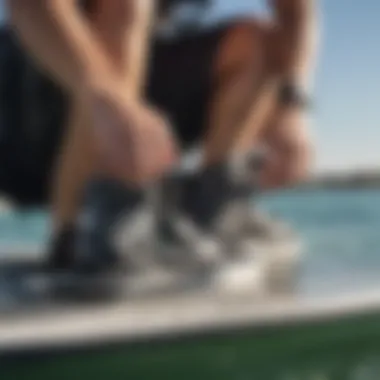
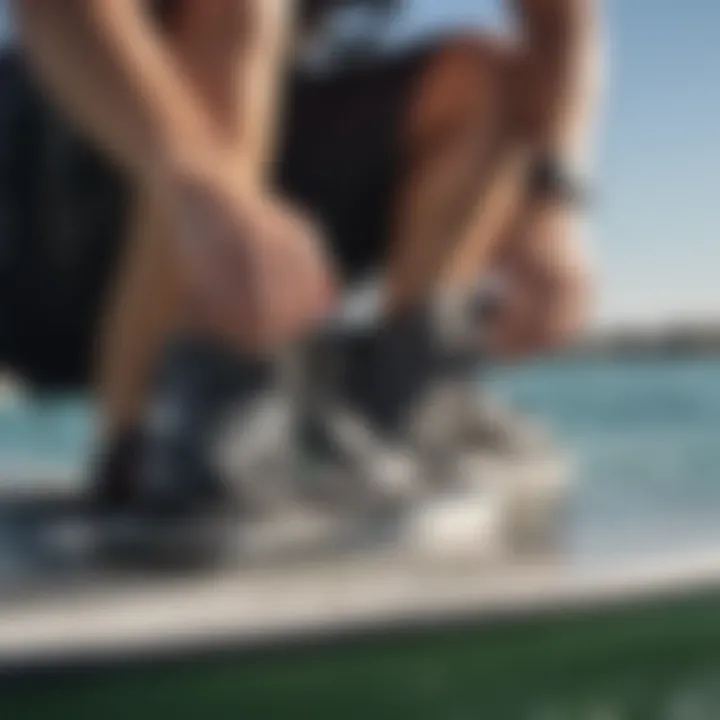
To mitigate these risks, make sure to consistently check the fit of your bindings. Many manufacturers include guidelines about tightening straps or fitting adjustments based on specific conditions, which should never be ignored.
In summary, the impact of binding fit on your performance extends beyond just style and trick execution; it directly influences control, stability, and ultimately, your safety on the water. By taking the time to find the right fit, you set the stage for a more enjoyable and secure wakeboarding experience.
Customization and Adjustment Options
Customization of wakeboard bindings is not merely an afterthought; it's a vital aspect that can significantly enhance a rider's experience. These adjustments allow for personal preferences and specific needs to be met, offering a tailored fit that can improve performance on the water. Whether you are just starting out or are a seasoned wakeboarder looking to refine your setup, understanding customization and adjustment options is paramount.
Liners and Footbeds
One of the essential factors in achieving comfort and optimal performance in wakeboarding is the choice of liners and footbeds. Liners are typically cushioned components inside the bindings that provide comfort and protection to your feet. When selecting a liner, it's crucial to consider materials that offer good breathability, padding, and moisture control, ensuring that your foot remains dry and comfortable during long sessions on the water.
Footbeds, on the other hand, are the surfaces where you rest your feet, and they play a key role in shock absorption and stability. A well-designed footbed aligns well with the contours of your foot and contributes to a better connection with the board.
- Key Benefits of Liners and Footbeds
- Increased Comfort: Proper cushioning prevents foot fatigue.
- Enhanced Control: A secure fit leads to better board handling.
- Performance Boost: Customized fit can improve your riding precision.
When adjusting liners and footbeds, look for options that allow you to tailor them specifically to your foot's width and shape. Some bindings even have removable liners, giving you the flexibility to replace them with upgraded versions or ones that conform better to your individual foot profile.
Strap and Buckle Modifications
Strap and buckle systems are crucial elements that determine how securely you are attached to your wakeboard. A snug fit is necessary to ensure control over your movements, but comfort should not be overlooked either. You want your bindings to feel like a second skin while ensuring they don’t disappoint you during those critical moments of a ride.
Many wakeboard brands now offer adjustable straps that give you the ability to customize the tension and fit according to your preference. Here are some aspects to consider:
- Ease of Use: Look for quick-release buckles that allow you to get in and out of your bindings with minimum hassle.
- Durability: Ensure straps are made from high-quality materials that withstand the rigors of wakeboarding.
- Fit Versatility: Adjustable straps can accommodate different foot shapes and sizes, providing that much-needed flexibility.
"A proper fit in your straps translates directly to performance on the water—don’t underestimate it."
In essence, the ability to modify straps and buckles gives wakeboarders the chance to create a secure and personal fit that can lead to a more enjoyable experience on the water.
Maintenance of Wakeboard Bindings
Proper maintenance of wakeboard bindings is vital for both performance and safety. The equipment undergoes a lot of stress from riding and environmental factors, so caring for your bindings helps ensure long-lasting durability. Like maintaining a well-tuned guitar for that perfect sound, a little effort can go a long way in achieving the best wakeboarding experience. Regular upkeep prevents problems that can arise from wear and tear, ensuring that bindings maintain their structural integrity and offer the support needed for agile maneuvers on the water.
Cleaning Tips
Keeping your bindings clean is one of the simplest yet most effective maintenance routines you can undertake. Here's a helpful checklist to get started:
- Rinse After Use: Always give your bindings a good rinse with fresh water after rides. Saltwater and sand can cause materials to break down over time.
- Gentle Wash: Use a soft cloth and mild soap to wipe down the outer and inner areas. Avoid using harsh chemicals; they can break down the straps and seals.
- Inspect for Dirt: Pay attention to dirt accumulation in the buckles and straps. A little brush work on these areas can prevent them from wearing out prematurely.
- Drying: Allow the bindings to air dry in a shaded area. Heat can cause certain materials to warp and lose shape.
Taking these steps can maintain the aesthetic of your bindings while also prolonging their lifespan.
Storage Recommendations
Where and how you store your wakeboard bindings can be a game changer in maintaining their condition. Here are some tips for keeping them safe:
- Keep Away from Direct Sunlight: UV rays can deteriorate the bindings, making them less effective. Store them in a cool, dry place, away from sunlight.
- Use Storage Bags: If you have them, using storage bags can provide an extra layer of protection. These bags keep out dust and dirt that can build up over time.
- Avoid Heavy Loads: Don’t stack heavy items on top of your bindings as this can lead to permanent deformation.
- Check for Damage: Before putting them away for the season, inspect for any signs of damage or wear. Address these issues before they become problems.
By taking a few more minutes to clean and properly store your binders, you can extend their life and maintain those crucial performance levels that every wakeboarder aims for.
"A stitch in time saves nine." Keeping a routine for care can help avoid bigger issues down the road.
The End
When it comes to wakeboard binding sizing, the stakes are high. This conclusion serves to crystallize the significance of ensuring the right fit for your bindings. It encapsulates the elements that weave together your experience on the water, underlining how precision in sizing can mean the difference between excellent performance and a disappointing ride.
Recap of Key Points
To streamline your understanding, here’s a recap summarizing the crucial points discussed throughout this article:
- Importance of Proper Fit: A proper fit influences not just comfort but also performance.
- Consider different sizing systems: Understanding US, EU, and UK sizing will help you avoid costly mistakes.
- Factor in your unique needs: Remember that personal riding style, skill level, and foot dimensions are essential when selecting bindings.
- Common mistakes to avoid: Not paying attention to manufacturer sizing guidelines can lead to poor choices.
- Impact on performance: Your control, stability, and even safety on the water depend profoundly on how well your bindings fit.
In the realm of wakeboarding, small details matter tremendously. Taking the time to truly comprehend these key aspects will not only enhance your experience but can also keep you safe.
Final Thoughts on Binding Sizing
In summary, binding sizing should never be treated as an afterthought. It’s the backbone supporting your wakeboard adventure. The right bindigs elevate your enjoyment, granting you peace of mind while you chase those waves. With the right knowledge and a bit of diligence, you can navigate the maze of options out there.
As you take the plunge into this dynamic sport, keep these insights close at hand. Whether you're a seasoned pro or just starting, a custom fit stands as your ally against the challenges of the water. Don’t skimp on the details, and always remember: a little extra care in selecting your bindings pays dividends when the board hits the water.



